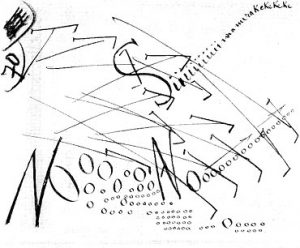The Custom of the Country: Colonialism and Naming in GGRW
For this assignment I have chosen to focus specifically on one recurrent feature of King’s Green Grass, Running Water, which I, while reading the novel, believed to be symbolic but for which no apparent explanation was provided in Jane Flick’s “Reading Notes for Green Grass, Running Water“.
There are numerous central characters in King’s novel, one of whom is Lionel Red Dog. Early in the narrative readers are introduced to Lionel’s sister, Latisha. Though slightly peripheral to the story, by comparison, Latisha is continually held up to Lionel as the accomplished foil to his own life’s failures. Indeed, as the proprietor of the famed Dead Dog Cafe (featured elsewhere in King’s works and on CBC Radio), Latisha certainly represents success- in all but one respect, that is. The reader learns that as s younger woman Latisha was married to a white American man named George Morningstar who, as Jane Flick notes, is meant to allude symbolically to General Custer (146). George continually refers to Latisha as “Country”, a strange nickname for which no explanation is ever given in the book.
The strangeness of this pet-name struck me immediately, especially in view of the fact that, as Flick’s “Reading Notes” demonstrates, King rarely passes up an opportunity to embed meaning and symbolism in the naming of his characters in GGRW.
Though George first refers to Latisha as “Country” on page 133, I have chosen to focus on pages 371-381. At this point in the narrative, Latisha has arrived at the annual Sun Dance, where she is confronted unexpectedly by her ex husband. Latisha, standing with her back to George, is aware of his presence before she actually sees him, because he addresses her, once more, as “Country”.
“‘Hello, Country.’ Even before she turned, Latisha’s arms instinctively came up and she stepped back, setting a distance between herself and the man behind her. ‘Hello, George,’ she said” (King, 371-372).
Over the course of the following ten pages, George attempts to take advantage of Latisha and her community for his own private purposes and thus the significance of George’s nickname for Latisha takes on clarity in view of their exploitative relationship. As Gillian Roberts states in Parallel Encounters: Culture at the Canada-US Boarder, “[George]… seems to think that he owns [Latisha] and it is now his responsibility to ‘cultivate’ her. George wants to colonize her,” and, in this respect, George “surely seems like an explorer and conquerer” (115).
The colonial subtext to Latisha’s nickname is expanded upon by Andrews, Davidson, and Walton in Boarder Crossings: Thomas King’s Cultural Inversions. Here, reference is made to Britain’s long standing political fear of American colonial influence over Canada, and the conclusion asserted by these authors is that King’s novel “ironically suggests that the same kind of aggressive colonization that nineteenth-century Canadians feared from Americans was, in fact, being perpetrated by Canadian settlers treatment of Natives” (164).
Thus, my research illustrates that George’s odd habit of referring to Latisha as “Country” becomes intelligible in view of a post-colonial analysis. Seemingly a term of endearment, Goerge uses this name to affect emotional and physically exploitation of Latisha. This tactic is particularly evidenced over the course of pages 371-381 depicting the climactic confrontation between George and Latisha at the Sun Dance; at this point in the narrative it becomes most evident that George’s naming and treatment of Latisha functions as both the literal correlative and symbolic evocation of white settler’s territorial colonization of lands belonging to Aboriginal peoples.
Works Cited
Davidson, Arnold E., et al. Border Crossings: Thomas King’s Cultural Inversions. Toronto: University of Toronto Press, 2003. Web.
Flick Jane. “Reading Notes for Thomas King’s Green Grass, Running Water.” Canadian Literature 161/162 (1999). Web. March 18h 2016. Web.
King, Thomas. Green Grass, Running Water. Toronto: Harper Collins, 1993. Print.
Roberts, Gillian. “Strategic Parallels: Invoking the Boarder in Thomas King’s Green Grass, Running Water and Drew Hayden Taylor’s In a World Created by a Drunken God.” Parallel Encounters: Culture at the Canada-US Border. Ed. Gillian Roberts and David Stirrup. Waterloo: Wilfred Laurier University Press, 2013. Web.

